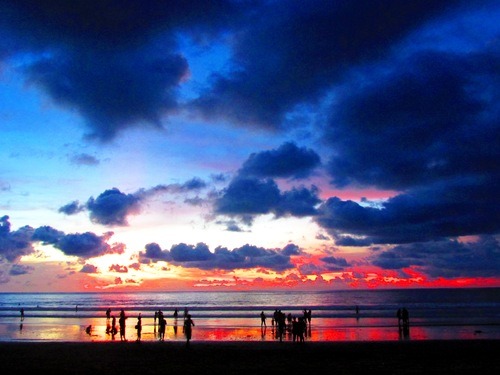“I have not seen so much skin since coming to Indonesia. And there are no jilbabs in sight.”
Sitting in the Denpasar Airport, waiting for the friend with whom I would be staying for the duration of my holiday travels, I was already experiencing a kind of reverse culture-shock, and I had not left Indonesia. The crowds passing by the secluded corner where I had tucked myself and my backpack were predominately white, English-speaking tourists, off to spend their holiday on the beaches of Bali. I looked down at my long batik skirt and conservative top, and felt completely out of place, when I should have felt more at home than I have in months. I sent a hasty SMS (the Indonesian phrase for “text”) to my sitemate, attempting to articulate how alien I felt in this place, and prepared myself for a holiday vacation that would be quite unlike anything I had ever experienced before.
Coming from a farming family for whom the perfect trip usually entailed going to some kind of cattle show, tropical vacation destinations have never really been on my radar, and so I had first learned about the island of Bali within the context of religion in Indonesia, as I researched the history of Islam in Indonesia for a project in an elective World Religions course. For a long time, I knew Bali mostly as the Hindu-majority island tucked into the middle of a Muslim-majority nation, a fascinating exception-to-the-rule that I hoped to be able to see first-hand during my time in Indonesia.
However, as I dove into every book my college library had on Indonesia, both for my World Religions class and to prepare for the nine months I would be spending in this spectacularly diverse country, I found that Bali also played a key role in discussions about cultural tourism and touristic culture. Tucked in between larger volumes I found a small book by Shinji Yamashita called Bali and Beyond: Explorations in the Anthropology of Tourism, which examines the ways in which the cultural tourism of Bali has begun to create a touristic culture. Essentially (to summarize an idea which is much more complex that I am about to make it sound), Bali’s focus on tourism as an economic necessity is changing the culture of Bali itself, and it has even altered the way Hinduism is practiced in many parts of the island.
Living on Java, in a Muslim-majority area in which any tourism that makes itself present focuses much more strongly on natural tourism rather than cultural tourism, I confess I have not given an excess of recent thought to either Hinduism in Indonesia or touristic culture. However, both these ideas were in the forefront of my mind during my short stay in Bali.
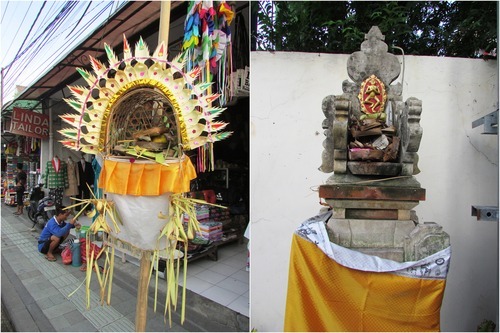
That Bali is a Hindu island became apparent from the moment we arrived: the architecture of the airport, like that of many buildings in Denpasar, the extremely touristy capital city in which my friend and I stayed, emulated that of Hindu temples; and from the windows of the taxi which took us to our hotel, I found myself gaping at huge statues of various Hindu gods and goddess, and losing count of the small shrines shattered in front of homes and shops. I did not hear the call to prayer once while I was in Bali, where pura-pura (Balinese for “temples”) are much more common than masjid-masjid (Indonesian for “mosques”), and it took me a few days to adjust to seeing small offerings—containing food, flowers, and the occasional cigarette—scattered about on the sidewalks everywhere we walked. I must admit that I know far more about Islam and other monotheistic religions than Hinduism and other “Eastern religions,” and I often had to ask guides and waiters what were probably beginner questions in order to contextualize what I was seeing around me.
But even as it was the smaller details that made it clear to me that Bali has maintained much of its religious roots, there were, of course, more grandiose examples of the culture which fuels so much of the tourism on Bali. While we only were able to visit a few of the larger temples—mostly on a day trip to Ubud, the city north of Denpasar perhaps most familiar as the setting of the Indonesian section of Elizabeth Gilbert’s Eat, Pray, Love—we did enjoy the ornate beauty of those we saw. My favorite was Pura Taman Saraswati, a temple in central Ubud dedicated to Dewi Saraswati, the goddess of wisdom and the arts. Gazing at its peaceful setting amidst trees and lotus flowers allowed me, for just a moment, to relish in the singular culture of this island, and forget the giant Starbucks directly behind me.
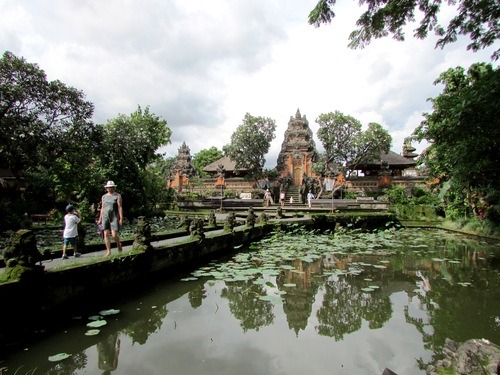
Hindu architecture and iconography followed us wherever we went, from temples to coffee shops to Ubud Palace, where the royal family still lives. The orange and red brick buildings and detailed stone carvings were very different from the colorful tile roofs of mosques and the brightly painted single-story houses I have become so accustomed to seeing in other parts of Indonesia, but I could not but appreciate the earthiness they exuded, and the contrast they provided to the brightly-lit shop signs that were scattered among them.
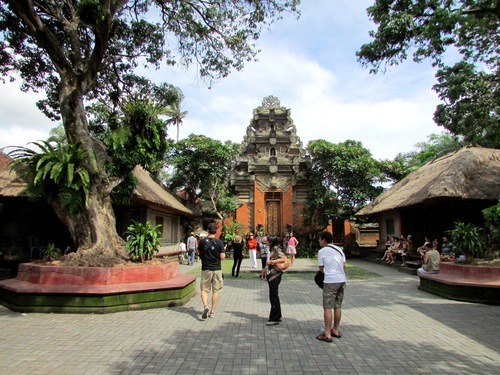
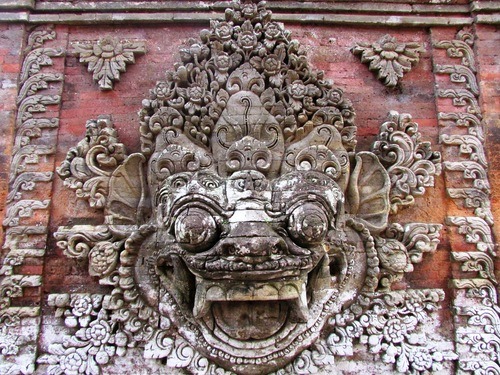
Ubud was by far my favorite part of our short visit to Bali, with its abundance of culture and its quieter tourism. My friend and I stayed in the Kuta area, which gave us excellent access to the beach and to a variety of restaurants and shops, but the particularly Western feel of Kuta, with its night life and English language dominance, was a continual source of discomfort for this American farm girl whose adaptation to Indonesian culture meant she could not stop saying “Maaf, permisi” (“Sorry, Excuse me”) to those who were clearly not Indonesian. In Ubud, though there were still more foreigners than I was accustomed to seeing, I felt as though I were still in Indonesia, albeit not the Indonesia that I live in every day.
The highlight of our day in Ubud was our visit to the Sacred Monkey Forest Sanctuary of Padangtegal, just south of Ubud. Inside the sanctuary were various Hindu temples, and the jungle surrounding them was stunning. The lush vines, towering trees, and almost swampy mugginess reminded this childhood Star Wars fan of the Dagobah system, and I do not think I would have been surprised if Yoda had hobbled out from behind a tree to impart a few words of wisdom.
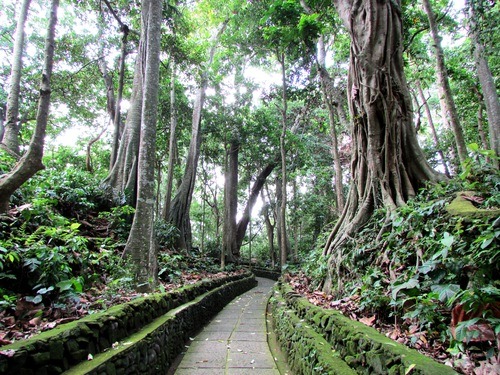
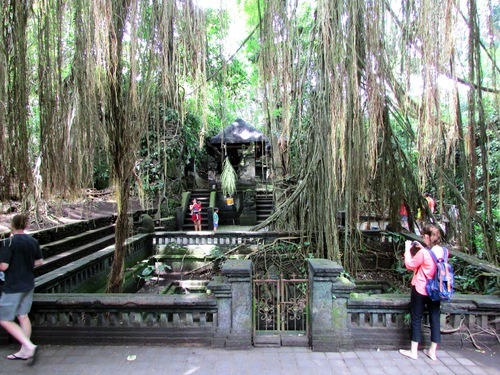
But though its scenery was gorgeous, the most memorable part of the Sacred Monkey Forest Sanctuary was, unsurprisingly, the monkeys. The sanctuary is home to over six hundred long-tailed macaques, which unabashedly climb over the statutes and temples. Tourism to the Sacred Monkey Forest Sanctuary has grown exponentially in recent years, a phenomenon which, while good for the economy, has changed the way those who work in the sanctuary, and in the surrounding village, endeavor to preserve the integrity of the area. As I unintentionally became the playground for a pair of juvenile macaques, and watched the unruly adult male who had decided I was not allowed to finish my vitamin water utilize his opposable thumbs to take off the cap and drink it himself, I could not shake the thought that this was touristic culture that even the wildlife could escape. At the same time, I was fascinated by the amazing adaptability of the creatures that seemed to generally go about their lives in a symbiotic relationship with the humans around them.

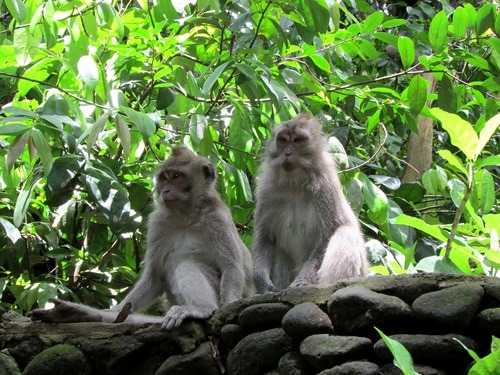
I was not always at ease in Bali, probably because it was the first time I was a proper tourist in this country. Prior to my holiday travel, I had always stayed with another ETA when I left my own site, and so while I was partially a tourist, I was also a friend being shown around the town that had become home for someone I care about. Bali was foreign and I was not with anyone who had created familiarity out of it, which occasionally made its stark contrast to my understanding of Indonesia a source of discomfort.
However, even as much of the Westernization of Bali felt uncomfortable, there is no denying that I benefited greatly from it, and quite honestly enjoyed much of it. I spent my Christmas day learning how to surf and building “snowmen” out of sand on Kuta beach, and everywhere we went we were told “Merry Christmas,” even though we were in no way in a Christian-majority part of Indonesia. Had I spent the holidays in a less touristy city, my experience would have been very different, and I found myself problematically thankful for it all.
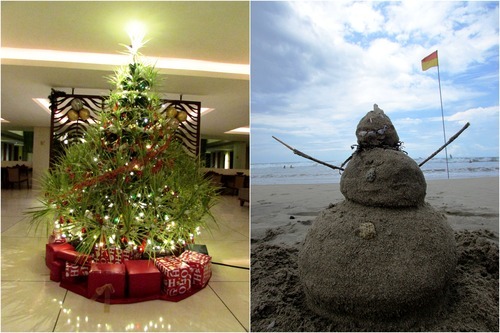
I was in Bali for a mere four days, and I will not pretend to have the experience or the anthropological understanding to draw any clear conclusions from my time there. But spending my holidays there gave me a fleeting look at an Indonesia that is very different from where I live, and will help me to further understand the discrepant parts that somehow come together to create the whole that is Indonesia. And that is something for which I can uninhibitedly be thankful.
